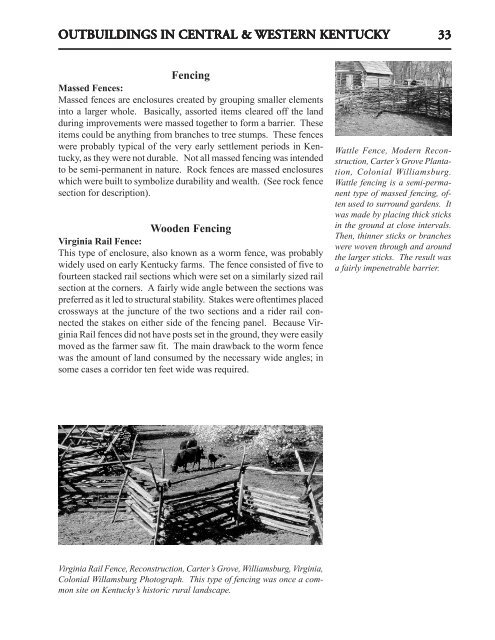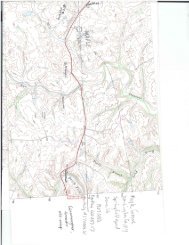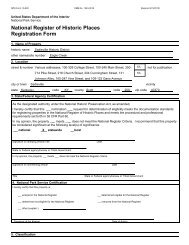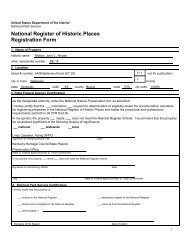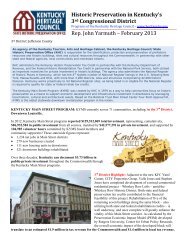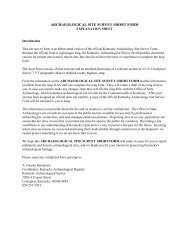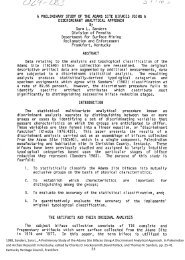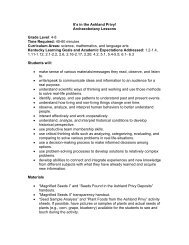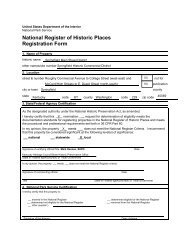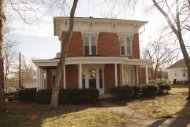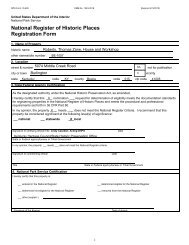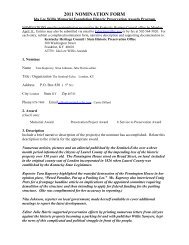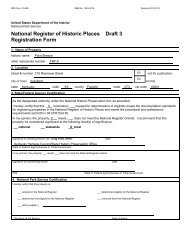Agricultural and Domestic Outbuildings in Central and Western
Agricultural and Domestic Outbuildings in Central and Western
Agricultural and Domestic Outbuildings in Central and Western
You also want an ePaper? Increase the reach of your titles
YUMPU automatically turns print PDFs into web optimized ePapers that Google loves.
OUTB OUTB OUTBUILDINGS OUTB OUTB UILDINGS IN IN CENTRAL CENTRAL & & WESTERN WESTERN KENTUCKY KENTUCKY 33<br />
33<br />
Fenc<strong>in</strong>g<br />
Massed Fences:<br />
Massed fences are enclosures created by group<strong>in</strong>g smaller elements<br />
<strong>in</strong>to a larger whole. Basically, assorted items cleared off the l<strong>and</strong><br />
dur<strong>in</strong>g improvements were massed together to form a barrier. These<br />
items could be anyth<strong>in</strong>g from branches to tree stumps. These fences<br />
were probably typical of the very early settlement periods <strong>in</strong> Kentucky,<br />
as they were not durable. Not all massed fenc<strong>in</strong>g was <strong>in</strong>tended<br />
to be semi-permanent <strong>in</strong> nature. Rock fences are massed enclosures<br />
which were built to symbolize durability <strong>and</strong> wealth. (See rock fence<br />
section for description).<br />
Wooden Fenc<strong>in</strong>g<br />
Virg<strong>in</strong>ia Rail Fence:<br />
This type of enclosure, also known as a worm fence, was probably<br />
widely used on early Kentucky farms. The fence consisted of five to<br />
fourteen stacked rail sections which were set on a similarly sized rail<br />
section at the corners. A fairly wide angle between the sections was<br />
preferred as it led to structural stability. Stakes were oftentimes placed<br />
crossways at the juncture of the two sections <strong>and</strong> a rider rail connected<br />
the stakes on either side of the fenc<strong>in</strong>g panel. Because Virg<strong>in</strong>ia<br />
Rail fences did not have posts set <strong>in</strong> the ground, they were easily<br />
moved as the farmer saw fit. The ma<strong>in</strong> drawback to the worm fence<br />
was the amount of l<strong>and</strong> consumed by the necessary wide angles; <strong>in</strong><br />
some cases a corridor ten feet wide was required.<br />
Virg<strong>in</strong>ia Rail Fence, Reconstruction, Carter’s Grove, Williamsburg, Virg<strong>in</strong>ia,<br />
Colonial Willamsburg Photograph. This type of fenc<strong>in</strong>g was once a common<br />
site on Kentucky’s historic rural l<strong>and</strong>scape.<br />
Wattle Fence, Modern Reconstruction,<br />
Carter’s Grove Plantation,<br />
Colonial Williamsburg.<br />
Wattle fenc<strong>in</strong>g is a semi-permanent<br />
type of massed fenc<strong>in</strong>g, often<br />
used to surround gardens. It<br />
was made by plac<strong>in</strong>g thick sticks<br />
<strong>in</strong> the ground at close <strong>in</strong>tervals.<br />
Then, th<strong>in</strong>ner sticks or branches<br />
were woven through <strong>and</strong> around<br />
the larger sticks. The result was<br />
a fairly impenetrable barrier.


